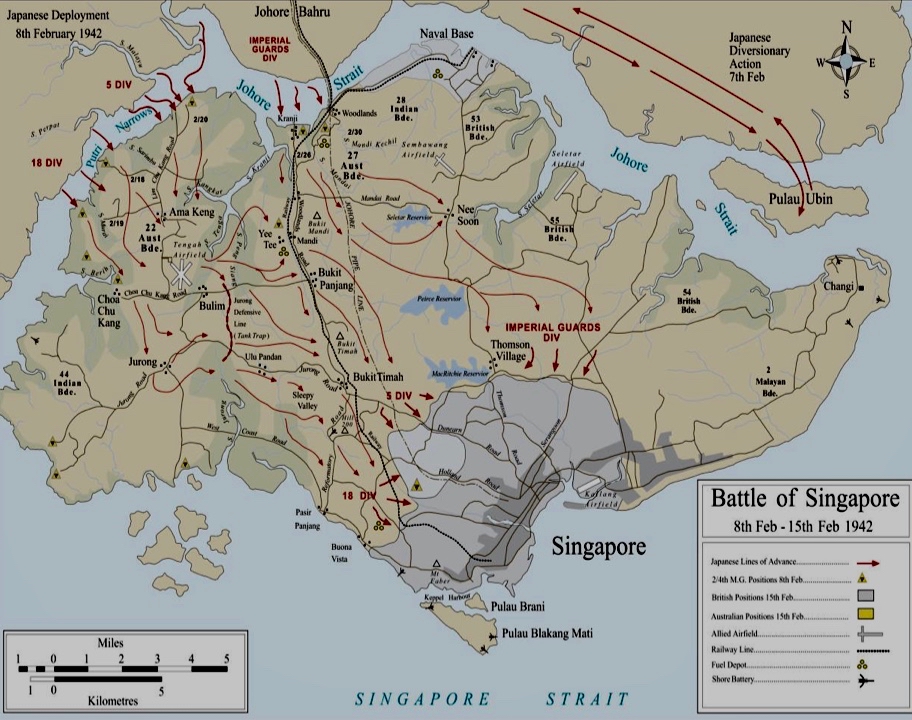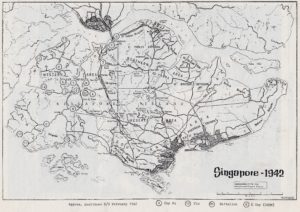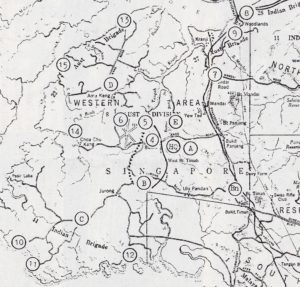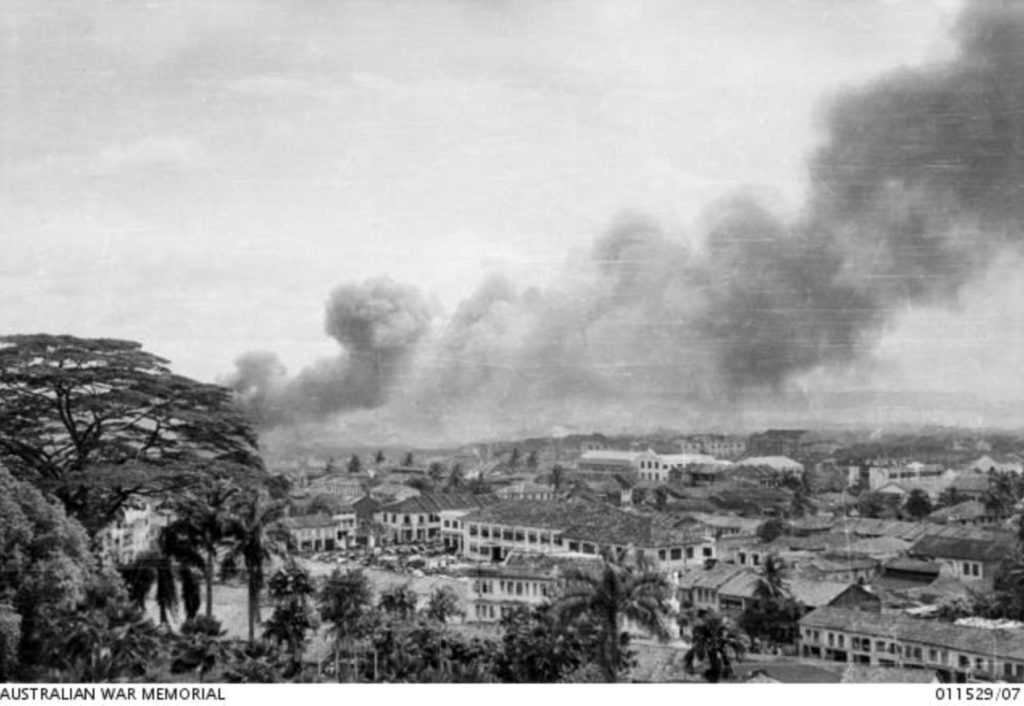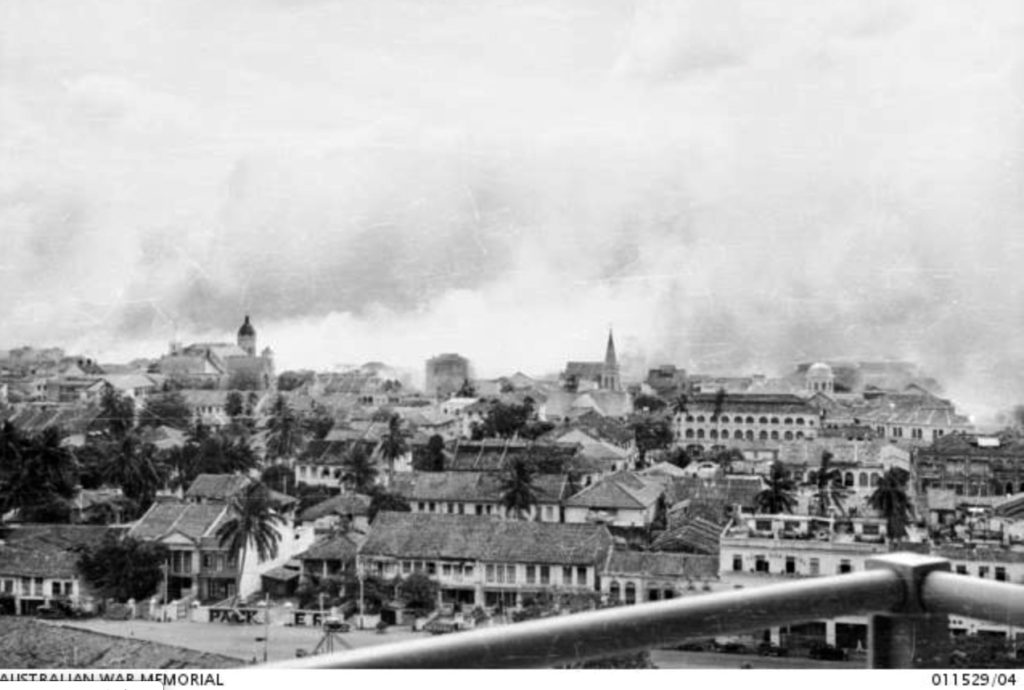Singapore’s Defence Plan
Defend the beaches or hold the line inland
2/4th MGB arrived Singapore 25 Jan 1942
Singapore totalled 220 square miles, extended about 26 miles West to East and about 14 miles from North to South. The Jahore Strait was up to 5000 yards wide east of the Causeway – but only 2000 yards at its widest point on the western side and narrowed to 600 yards. The Naval Base was on the northern shore east of the Causeway. The City of Singapore was located on the South coast.
There were few major roads, the Island was covered with rubber and other plantations with secondary jungle. The highest points were in the centre of the island as were water reservoirs (supplemented by supplies from Jahore). The Northern and Western areas were fringed by coastal swamps intersected by innumerable creeks and two major river systems. There were three military and one civilian airfields on Singapore.
Withdrawal from Malaya
At 0815 hrs 31 Jan 1942 with all Allied troops had been withdrawn from Malaya – a gap of 70 feet was blown in the Causeway linking Malaya and Singapore Island.
A military decision had been made earlier to defend the entire 72 miles of Singapore’s coastline – this decision thought to have been made by Lt-Gen Arthur Percival, however it appears the originator was really Air Vice Marshall Sir Robert Brooke-Popham. The other option being to hold the Allied lines further inland.
The greatest challenge facing Allied Forces was lack of fighting forces –the battalions who had fought in Malaya had lost lives and of those who returned many were injured and all were weary. Reinforcements of Australia and Indian troops had been arriving in Singapore since mid January. Too many lacked training and all were inexperienced.
Work had commenced as late a 3 Feb 1942 on the digging of an Anti-Tank ditch on the defensive line on Singapore’s coast. Except for swamp at its northern and southern extremities, the Kranji-Jurong area was sparsely timbered – offering fields of fire of up to 250 yards – ideal for the Vickers machine guns.
On the night 8 Feb 1942 Japan attacked the west coast of Singapore where the Anti –Tank ditch had been completed, but little done to prepare infantry positions.
The total number of uniformed Allied troops was 85,000.
The greatest problem was the composition of the Allied forces.
Japan’s infantry troops amounted to 50,000 in 70 Battalions with about another 25,000 attendant combat support troops, artillery, armour, engineering, bridging, reconnaissance. There were few non-combatant troops in the Japanese Army spearheading their drive through Malaya to Singapore. Whereas Singapore’s base /administrative centre was heavily staffed by British.
Throughout the Malaya Campaign Japan always had fresh Battalions to relieve front line troops. They assembled about 35 Battalions of fresh troops for the assault on Singapore and had the ability to concentrate troops in strength anywhere on the vulnerable coastline.
The total infantry forces to defend Singapore was the equivalent of 13 infantry brigades – three British and two Australian (22nd and 227th Brigade) The reality was quite different.
The British 18th Division and 53rd Brigade arrived Singapore 18 Jan 1942 and had been in action in Malaya.
The 54th and 55th arrived 5 Feb 1942 (three days prior to Japanese attack). One ship in the convoy Empress of Asia was bombed entering the harbour – most troops were rescued but all their equipment was lost.
They with the 28th Indian Brigade and 8th Indian reserve Brigade (both had been reconstituted) the British Division was responsible for the northern area of 14 miles of coastline from Causeway to Changi.
The remaining British troops made up of two Malayan Brigades, a SSVF (militia) Brigade and British Fortress troops (3 Battalions) covered the southern coast.
Recently arrived and inexperienced 44th Indian Brigade in south west sector provided the link with the Australians on north west Coast.
Reserves: 3rd Indian Corps was the only shattered British Battalion remaining and what was left of the Argylls.
The Indian Battalions who had lost heavily in Malaya were brought up to strength with 60% reinforcements. Several were labour Battalions and most had limited training and nearly all were short of Officers.
With the exception of two Australian Brigades nearly every Battalion was short of equipment. The effective strength of what was 39 Battalions was in fact no more than 25 Battalions – many of doubtful value, to protect a 70 mile coastline.
AUSTRALIAN FORCES:

